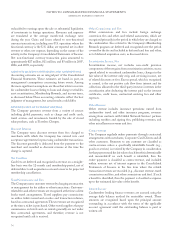American Express 2007 Annual Report Download - page 80
Download and view the complete annual report
Please find page 80 of the 2007 American Express annual report below. You can navigate through the pages in the report by either clicking on the pages listed below, or by using the keyword search tool below to find specific information within the annual report.NOTES TO CONSOLIDATED FINANCIAL STATEMENTS
AMERICAN EXPRESS COMPANY
recorded in earnings as a component of other, net expense. If a
fair value hedge is de-designated or terminated prior to maturity,
previous adjustments to the carrying value of the hedged item
are recognized into earnings to match the earnings pattern of
the hedged item.
Net investment hedges in foreign operations
A net investment hedge in foreign operations is a derivative used
to hedge future changes in currency exposure of a net investment
in a foreign operation. For derivative financial instruments that
qualify as net investment hedges in foreign operations, the
effective portions of the change in fair value of the derivatives
are recorded in accumulated other comprehensive (loss) income
as part of the cumulative translation adjustment. Any ineffective
portions of net investment hedges are recognized in other, net
expense during the period of change.
Non-designated derivatives and trading activities
For derivative financial instruments that do not qualify for
hedge accounting, are not designated as hedges, changes in
fair value are reported in current period earnings generally as
a component of other revenue, other, net expenses or interest
expense, depending on the type of derivative instrument and
the nature of the transaction.
Derivative financial instruments that qualify for hedge accounting
Derivative financial instruments that are entered into for
hedging purposes are designated as such when the Company
enters into the contract. For all derivative financial instruments
that are designated for hedging activities, the Company
formally documents all of the hedging relationships between
the hedge instruments and the hedged items at the inception of
the relationships. Management also formally documents its risk
management objectives and strategies for entering into the hedge
transactions. The Company formally assesses, at inception and
on a quarterly basis, whether derivatives designated as hedges
are highly effective in offsetting the fair value or cash flows of
hedged items. These assessments usually are made through the
application of statistical measures. Prior to 2006, the Company
only applied the “short cut” method of hedge accounting in very
limited cases when this method’s requirements were strictly
met. Beginning in 2006, the Company discontinued using the
“short cut” method of hedge accounting.
In accordance with its risk management policies, the
Company generally structures its hedges with very similar terms
to the hedged items; therefore, when applying the accounting
requirements, the Company generally recognizes insignificant
amounts of ineffectiveness through earnings. If it is determined
that a derivative is not highly effective as a hedge, the Company
will discontinue the application of hedge accounting.
Income Taxes
The Company, its wholly-owned U.S. subsidiaries, and certain
non-U.S. subsidiaries file a consolidated federal income tax
return. The Company is subject to the income tax laws of the
United States, its states and municipalities and those of the
foreign jurisdictions in which the Company operates. These tax
laws are complex, and the manner in which they apply to the
taxpayer’s facts is sometimes open to interpretation. Given the
inherent complexities of the business and that the Company is
subject to taxation in a substantial number of jurisdictions, the
Company must make judgments in assessing the likelihood that
a tax position will be sustained upon examination by the taxing
authorities based on the technical merits of the tax position.
The amount of benefit recognized is based on management’s
best judgment of the most likely outcome resulting from
examination given the facts, circumstances and information
available at the reporting date. Interest and penalties relating to
unrecognized tax benefits are reported in income tax provision.
Deferred tax assets and liabilities are determined based on
the differences between the GAAP financial statement and
tax bases of assets and liabilities using the enacted tax rates
expected to be in effect for the years in which the differences
are expected to reverse. A valuation allowance is established
when management determines that it is more likely than not
that all or some portion of the benefit of the deferred tax assets
will not be realized.
The Company does not provide for federal income taxes on
foreign earnings intended to be permanently reinvested outside
the United States.
Restricted Net Assets of Subsidiaries
Certain of the Company’s subsidiaries are subject to restrictions
on the transfer of net assets under debt agreements and regulatory
requirements. These restrictions have not had any effect on the
Company’s shareholder dividend policy and management does
not anticipate any impact in the future. Procedures exist to
transfer net assets between the Company and its subsidiaries,
while ensuring compliance with the various contractual and
regulatory constraints. At December 31, 2007, the aggregate
amount of net assets of subsidiaries that may not be transferred
to American Express’ Parent Company (Parent Company) was
approximately $7 billion (this includes restrictions on the net
assets of Discontinued Operations of $1 billion).
RECENTLY ISSUED ACCOUNTING STANDARDS
The Financial Accounting Standards Board (FASB) has recently
issued the following accounting standards, which are effective
beginning January 1, 2008. The adoption of the accounting
standards listed below will not have a material impact on the
Company’s financial position or results of operations.
78
























